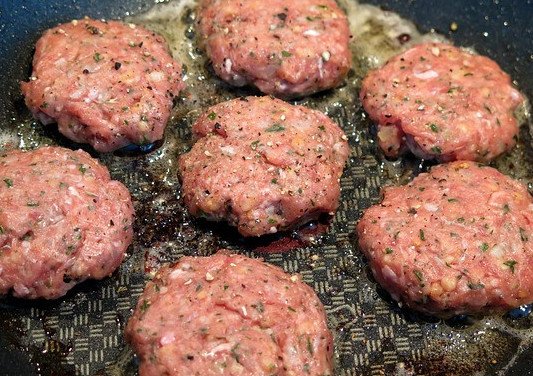There are many, many causes of blocked drains and identifying the cause of your blockage can help resolve and often minimise repeat problems.
In no particular order of severity, here are some of the most common causes of blockages affecting toilets, sinks, manhole chambers, etc.
- Fats, oils & grease
- Wipes – Even “flushable” products!
- Excessive paper
- Roots
- Ground movement
- Foreign objects – such as toys or cotton buds or even clothing!
- Poor plumbing – such as a poor flush from the toilet or a flat waste pipe
How to Clear Fats, Oils and Grease from a Blocked Drain

Of all the things that cause drainage issues, fat and grease can be the most unpleasant. If it ends up overflowing or you make a mess of it when clearing it, the grease clings to every surface and it can be a nightmare getting it out of carpet or clothing.
Before we cover how to attack it, let’s start with the cause:
What Causes Fat & Grease Build Up in Drains?
Food. Sauces. Oils. Cooking oil. Pretty much any process that involves prepping or cooking food can contribute to a blocked drain by causing grease to build up and fat to solidify.
Let’s assume you’re not pouring hot oil down the sink to dispose of it, why does it build despite how careful you are?
When washing up, even if you scrape all the leftover food and all excess ketchup or mayonaise or other sauces into the bin or food waste or composting bin, there is usually some residue left over, whether you’re washing up by hand or using a dishwasher.
Over time, these bits of food and residues from plates, cutlery and pans coat the inside of the pipe, like a lining. The majority of solids will either get stuck in the U bend, other bends downstream or simply flow further down into the main drainage that takes the rest of your property.
The fats and oils, however, tend to coat the pipe as it cools down and clings to the pipe as it solidifies. This can then catch the solids that would otherwise escape. Over time, the inside of the pipe becomes more constricted and reduces the amount of water your pipe can take.
At this point, you will notice either a gradual blockage where the sink starts becoming slow to drain or it just stops draining altogether.
Most fat blockages occur close to the source, affecting the kitchen sink or gully outside, but fat and grease can cause major issues with the entire household depending on the circumstances.
For the most effective methods on attacking a blocked drain caused by fat & grease, click here.
Wipes

Baby wipes, make-up removal wipes, cleaning wipes, whatever else wipes are used for, should catergorically not be flushed down a toilet or drain.
Chances are, blocked drains caused by wipes are the most avoidable cause but also most common cause. Some products claim to be “flushable” on the packaging. Somehow the manufacturers get away with this claim, but it is very misleading.
Even if they do flush, as in you flush the toilet and they disappear, they inevitably stop, or stall, at every bend and direction change.
Let’s Compare Wipes to Normal Toilet Tissue
Let’s start with a toilet on the first floor, upstairs.
First off, we’ll start with normal toilet tissue. You flush, the tissue disappears and you forget about it. As you are washing your hands, that paper has travelled through the U bend of the toilet and is being carried away with the flow of the water.
The paper will follow the pipe along any bends and straight pipe until it hits the stack pipe, a vertical pipe that takes waste water from one floor to another, often straight into the underground drainage. Along it’s route, the paper will break up and disintegrate into smaller pieces until what’s left is a mush of smaller strands that gets easier and easier to get away with the flow of water. With one flush, the paper in question will likely be in the main sewer, septic tank or pump station in many pieces and breaking down until nothing remains.
Wipes, however, are a different story.
Same toilet on same floor, but now it’s a couple of “flushable” wipes being flushed down the toilet.
Same U bend, same pipe, same bends and route to the destination off the property.
Only in this case, the wipe doesn’t break up and stalls at every opportunity. They may move on when the toilet is next flushed, but they usually don’t get far. Then they build up into a bundle.
Even if they make it as far as the main sewer, they will not break up and may cause issues further along. Even more so if your waste drainage runs to a septic tank or pump station. In a septic tank, they will just sit there and add solid mass to the tank as opposed to paper and everything else that breaks down naturally.
And if pumps are involved, then wipes will add wear to the blades, or impellors, of the pumps and potentially block them completely by jamming the moving parts or cause overheating of the motors. Either of which can be costly to diagnose and repair.
For help dealing with wipes, click here.
Excessive Paper
This is possibly the easiest of blockages to clear and is usually caused by children or the elderly. Especially when a poor flush is involved. Normally the blockage is closeby and easy to shift. Once dislodged, just keep flushing to keep it moving along!
Roots

Roots from all kinds of plants, from shrubbery to the largest trees, can have an impact on your drainage.
Roots seek water and nourishment, and what better water and nourishment source than your drainage pipe!
Roots can invade a drainage system in a few different ways. The easiest is probably from between joints in the pipe, especially old pipe that has become displaced due to ground movement. Once they tap into this source of water, the plant is encouraged to grow more and more this can further affect the pipe at the same time as clogging it.
Roots can also get in through any inspection chambers or covers. For example, they can grow through old brickwork or gaps in the mortar. Sometimes they can grow through any gaps where the inspection cover sits on a frame, or between frame and brickwork/plastic structure.
When they grow within inspections chambers or manholes, they can be removed my cutting and pulling out, then make sure to seal the gap or repair as necessary. If they are in the pipe, you can remove with rods but may need a drainage contractor to deal with it and use CCTV to check they’re all out and dealt with.
For further help with dealing with roots, click here.
Ground Movement
This can be subtle or extreme, as in you don’t notice as it’s below ground, or extreme in the case of subsidence.
Either way, this can cause pipe to move with the ground. Now, if installed correctly, there should be enough bedding around the pipe to allow some flex and minimise the movement.
However, some joints may become displaced and cause blockages by stalling solids, or allow substrate from the ground into the pipe. In some cases it can cause the pipe to break, especially with clay pipe or pipe laid with no support or bedding.
For more help with ground movement problems, click here.
Foreign Objects
This could be a toilet cleaner accessory, such as a rimblock that sits on the inside of the toilet, or a child’s toy. Either way, the best thing to do is remove, or make sure it gets to the main sewer where the pipe is larger and has much faster flow.
Poor Plumbing
Let’s break this down into two primary causes:
Plumbing – the water feed
Wastepipe – the drainage aspect of the plumbing
Plumbing
Eco flushes are becoming the norm now, and for good reason. However, if not enough water is flushed through after a toilet is used, this can lead to the solids stalling and builiding up in the same manner as wipes and foreign objects, as mentioned above.
It may not even be that the flush itself is at fault, but problems can also occur if it takes too long for a cistern to refill after flushing.
For example, if there is only one toilet on the property and many people, it may not be filling quickly enough for a full flush after the first use.
A plumber should be able to rectify this, however if you’d rather try it yourself, try our Basic DIY Plumbing section.
Wastepipe
A poorly installed wastepipe, particularly when it serves toilets, can have a massive impact on the flow and function of your property’s drainage.
Some examples could be:
- Too many bends
- Not enough fall – or gradient in the pipe between upstream and downstream, such as between toilet and stack pipe.
- Poorly installed pipe, such as misaligned joints or protruding connections from other facilities, such as a 2″ sink wastepipe entering the main wastepipe.
- Uninsulated external pipe or within areas prone to cold, such as attics that cause pipes to freeze.
Hopefully this has helped you in some way. We will expand upon common causes and update with new content to help you with your drainage problems as often as we can, but for now feel free to leave a comment below!
